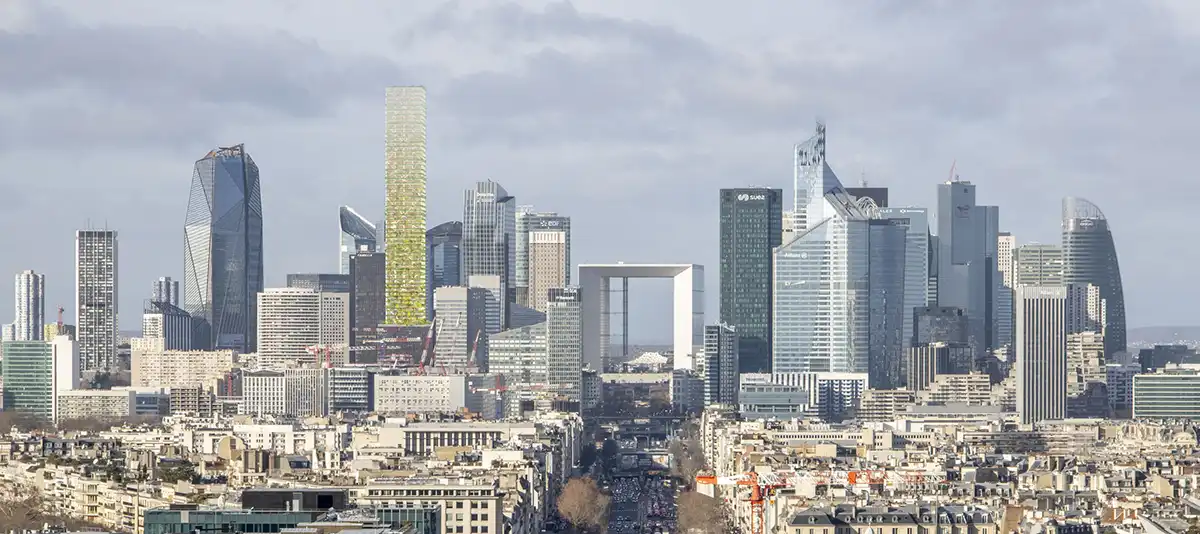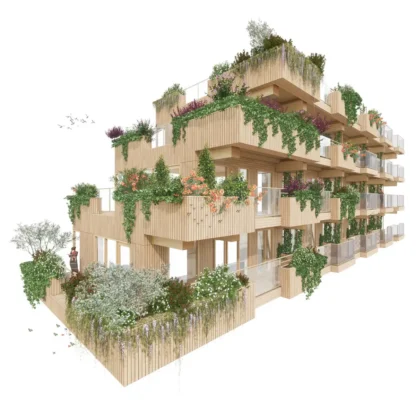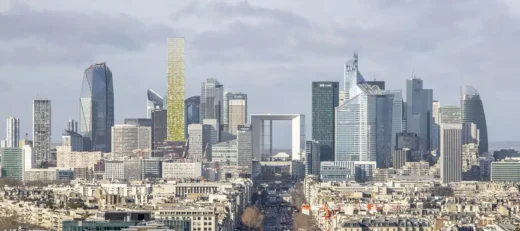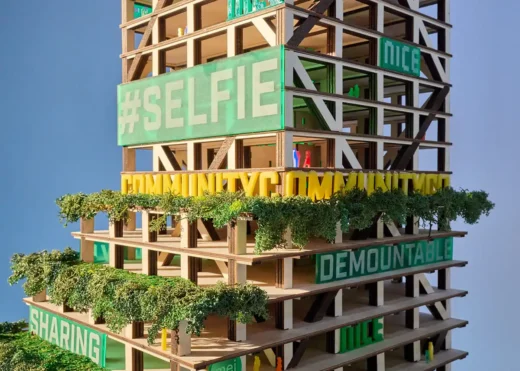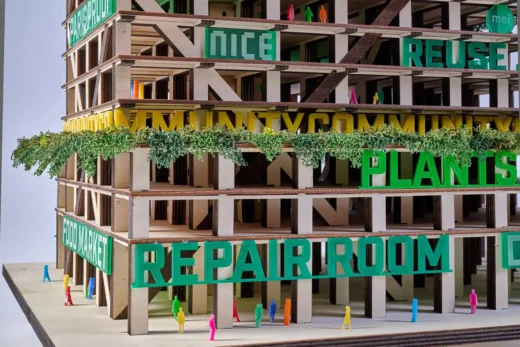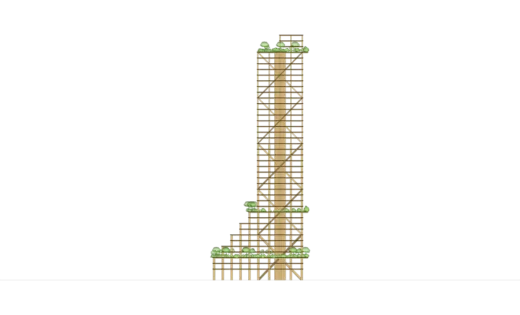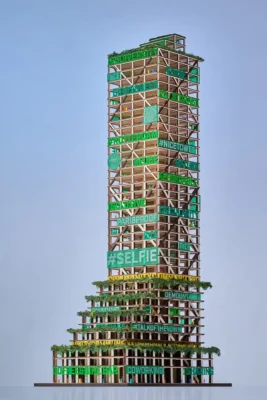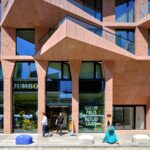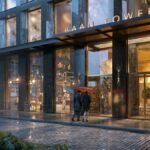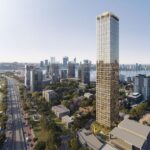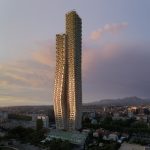NICE Tower timber building design news, Tall wood architecture, Dutch circular high-rise property
NICE Tower Timber Building
High-rise architectural project in Holland design by Mei architects and planners, Netherlands
2 May 2025
The future of sustainable and circular high-rise buildings
Design: Mei architects and planners
Photos by Frans Parthesius
NICE Tower Building Made of Wood
The NICE Tower, an impressive 140-meter-tall structure made entirely of wood, represents the next step in the revolution of circular timber high-rise construction. The tower derives its stability from wooden bracing in the façade and a wooden elevator core, is fully bio-based, and is entirely free of concrete from the ground floor to the lift core and supporting structure. This drastically reduces CO₂ emissions compared to traditional concrete buildings and helps combat global warming.
The building offers a sustainable and inclusive residential program in response to the increasing pressure on urban space. Its stepped design, featuring communal rooftop terraces, fosters social interaction, while the nature-inclusive design contributes to biodiversity and strengthens ecological structures.
Elevating circular timber construction
The world faces immense challenges: to slow down global temperature rise, CO₂ emissions must be drastically reduced. Although clear agreements have been made in the Paris Climate Agreement, the European Green Deal, and the UN Sustainable Development Goals, construction still primarily relies on concrete and steel, materials that significantly contribute to CO₂ emissions.
Moreover, there is a growing housing crisis, a shortage of affordable homes, increasing urban loneliness, and a decline in biodiversity. Material scarcity also necessitates an urgent re-evaluation of construction methods, emphasizing reuse, regenerative and reusable materials, and circular construction techniques as essential for responsible future building.
In 2019, Mei collaborated with NICE Developers to create SAWA, the unique and circular wooden residential building in Rotterdam. With the NICE Tower, NICE Developers challenges Mei to elevate circular timber construction to an even higher level. SAWA serves as both a prototype and an inspiration for a new sustainable standard. The NICE Tower proves that circular high-rise construction is possible, even on a large scale.
CO₂ reduction through timber construction
By building with timber, such as CLT (Cross Laminated Timber) and Glulam, the structure not only stores CO₂ and drastically reduces emissions but also allows for faster, lighter, and more sustainable construction. This makes the NICE Tower a ‘Paris Proof’ building, aligning with all current and future climate goals.
To achieve climate targets, drastic measures must be taken. A concrete tower emits an average of 450 kg CO₂ per m². By 2030, this must be reduced to 139 kg CO₂ per m². The NICE Tower can meet this ambitious target.
This means that within the CO₂ emissions of a single traditional concrete tower, as many as three bio-based NICE Towers could be built! Not only is CO₂ emissions significantly reduced, but within the available CO₂ budget, more housing can also be realized.
Circular and future-proof
To prevent the depletion of the planet’s resources, it is essential to use as many reused and regenerative bio-based materials as possible. The NICE Tower is entirely bio-based and designed for circularity. The floors are constructed with CLT topped with reused dry mass instead of poured concrete. The wooden structure is prefabricated in the factory and assembled on-site using screws, making all structural components demountable and reusable in the future. This contributes to the building’s longevity and circularity.
The NICE Tower’s design follows the Open Building principle: the main supporting structure consists of floors, beams, and columns. This ensures that the residences and workspaces can easily adapt to changing needs in the future.
Enhancing biodiversity
The impact of urbanization on people and the environment is evident, from waterlogging to heat stress and rising CO₂ emissions. At the same time, urban development is shrinking the habitat of birds, bees, butterflies, and other insects. Enhancing biodiversity is an essential part of the NICE Tower’s vision.
The tower contributes to a healthy living environment with a nature-inclusive design, developed in collaboration with urban ecologists and biologists. Various floors incorporate planters and green terraces specifically designed to support local flora and fauna. Nesting boxes, providing a safe habitat for birds and insects, are integrated into the design, reinforcing urban biodiversity.
Affordability, social inclusivity, and health
The NICE Tower is designed with a strong focus on social cohesion and affordability. Loneliness is a growing problem affecting all age groups, carrying not only emotional but also serious health risks. Additionally, in many cities, middle-income residents struggle to find affordable housing. The mix of owner-occupied and rental homes in various price categories accommodates a diverse community, including residents in essential social roles, such as education and healthcare.
The architecture fosters encounters and connections with communal rooftop terraces and designated spaces for shared facilities. These facilities, including mobility services, DIY workshops, urban gardens, and social meeting spots, contribute to a close-knit community, promoting residents’ well-being and health.
The ground floor and central levels feature various social and local initiatives, such as co-working spaces, a bike bar, childcare facilities, a cinema, a community center, and hospitality services. These amenities enhance the vibrancy of both the building and its connection with the surrounding neighborhood.
NICE Tower Rotterdam – Building Information
Title: NICE Tower
Status: Concept in 2024
Client: NICE Developers
Program: Mix of owner-occupied and rental housing, commercial, and social functions
Size: 34,000 m2
Mei Team: Robert Winkel, Robert Platje, Michiel van Loon, Joost Wetzel, Geert Krusemann, Marloes Bier, Minh Nguyen, Meng Chen, Martina Marinova, Sanne Pijnappel, Anton de Koning.
Structural engineering consultant: Pieters
Paris Proof calculations: Merosch
Fire safety consultant: Adviesbureau Hamerlinck
Location: To be determined
NICE Tower Rotterdam building design images / information received 020525 from Mei architects and planners
Location: Rotterdam, The Netherlands
Architecture in Rotterdam
Rotterdam Architecture Designs – architectural selection below:
Rotterdam Architecture Designs – chronological list
Rotterdam Architecture Walking Tours
Lijnbaan in Rotterdam
Design: Mei architects and planners
Rotterdam Architecture – selection:
Portlantis Visitor and Exhibition Centre Rotterdam Building
Design: MVRDV, Architects
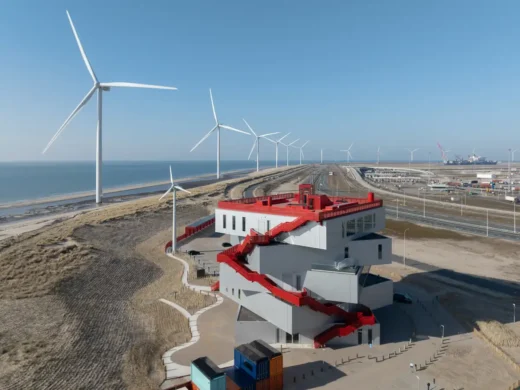
photo © Ossip van Duivenbode
BaanTower Rotterdam buildings
Design: Powerhouse Company
Langeveld Building
Design: Paul de Ruiter Architects
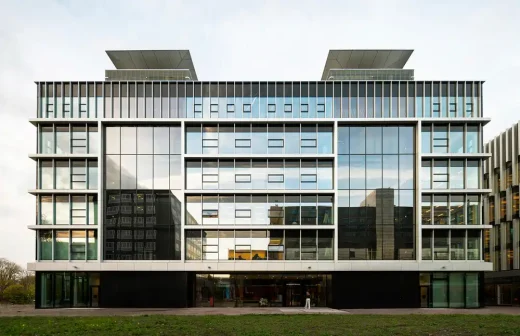
photo : Aiste Rakauskaite
FENIX Museum of Migration in Rotterdam
Design: MAD Architects, China
Museum Boijmans Van Beuningen
Design: MVRDV, architects
Weenapoint complex
Design: MVRDV Architects
Rotterdam Architecture Studios – design firm listings on e-architect
Buildings / photos for NICE Tower timber building design by Mei architects and planners, Netherlands page welcome.

